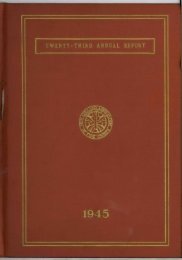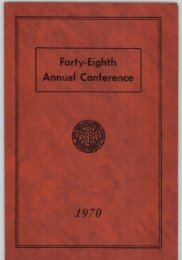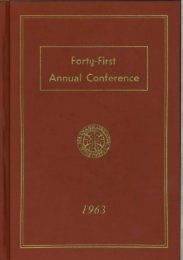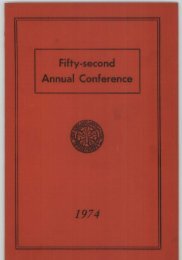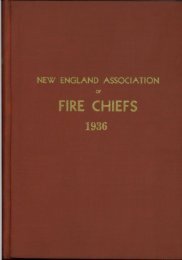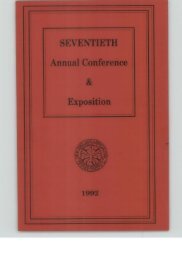NEAFC 31st Annual Conference.pdf - New England Association of ...
NEAFC 31st Annual Conference.pdf - New England Association of ...
NEAFC 31st Annual Conference.pdf - New England Association of ...
Create successful ePaper yourself
Turn your PDF publications into a flip-book with our unique Google optimized e-Paper software.
NEW ENGLAND ASSOCIATION OF FIRE, CHIEFS<br />
In a 16 tt line operating at 750 psig the bursting pressure for each lineal foot is<br />
72 tons..As the only force in opposition to this bursting are the two sidewalls <strong>of</strong><br />
or even less in thickness, it is easy to see why ruptures have occurred due to even<br />
relatively minor changes in pipe stress. These have been attribut£d to a myriad <strong>of</strong> causes<br />
including ~basic failure <strong>of</strong> the pipe or welds~ corrosion, electrolysis, traffic vibration,<br />
earth tremors, nearby .blasting, washouts, land settlements, floods, erosion, mechanical<br />
damage to the pipe, etc.<br />
Since the sheer strength <strong>of</strong> steel is very much less than its bursting strength, there<br />
is a great likelihood that even a slight rupture will tear into a long horizontal break at<br />
the instant =o.f rupture. In one outstanding example at King <strong>of</strong> Prussia, Pennsylvania,<br />
such a:~ea~:extended for so.me 3,150 feet until finally stopped by the construction at a<br />
railroad underpass.. The thirty-inch pipe involved was ripped into ribbons, as though<br />
by giant pinking shears, and spewed all over the right-<strong>of</strong>-way, with sizable pieces even<br />
locgmg in the tops <strong>of</strong> trees..<br />
In the case <strong>of</strong> a simple rupture, where ignition does. not occur, the hazard is<br />
usually limited to the danger <strong>of</strong> being struck by the pipe, pipe fragments, rocks, or<br />
other debris. In one instance, on the occasion <strong>of</strong> a break in Northern Connecticut, a<br />
housewife described a veritable rain <strong>of</strong> rock and stones around her home, some 750<br />
feet from the pipe line. Unsuccessful attempts have been made to require transmission<br />
companies to exclude rocks and large stones from backfill; the companies being in opposition<br />
because, among c,ther reasons, such heavy fil! he_lps to hold the pipe down in the<br />
event <strong>of</strong> a rising water table..<br />
After the initial blast damage, the obvious"danger <strong>of</strong> a rupture is the ever-present.<br />
one <strong>of</strong> ignition. Since the Unitedi States Bureau-~-f- M~nes has determined that ignition<br />
<strong>of</strong> a natural gas-air mixture occurs with static sparks <strong>of</strong> 2/10 <strong>of</strong> a millijoule, with this<br />
being 1,000 times less energy than that liberated by-the combustion <strong>of</strong> the smalleit<br />
particle <strong>of</strong> coal that can be weighed on a sensitive analytidal balance, it is safe to assume<br />
that nearly all major high pressure pipeline rupture will be followed by fire. At least<br />
this assumption should be used as a bagis .for the complete evacuation <strong>of</strong> the area <strong>of</strong> a<br />
leak, and <strong>of</strong> keeping even. firemen and other emergency workers at a safe distance at<br />
all times. Anyond whb has ever been singed by the puff <strong>of</strong> a gas oven that was a<br />
little too full <strong>of</strong> gas-air mixtures when lighted, will know that "safe distance" does<br />
not mean adjacent to the column <strong>of</strong> escaping gas. Moreover, in anticipating ignition<br />
it is well to remember that a small stone striking the pipe or debris may be all that is<br />
needed.<br />
Under ordinary conditions existing i-n ho~es=xnd ih-industry, it is difficult to<br />
insure the complete absence <strong>of</strong> such sources <strong>of</strong> ignition as, open flames, static sparks,<br />
inductive sparks, electric arcs, hot wires, compression, shock, friction, heated surfaces,<br />
and hot flying particles.<br />
As distinguished from a rupture even though the same may be, and usually is,<br />
followed by fire, an explosion consists <strong>of</strong> the actual chemical : combination <strong>of</strong> gas and<br />
oxygen, usually under relatively close confinement. If a combustible gas is added continuousiy<br />
to a given quantity <strong>of</strong> air the concer~tration<strong>of</strong> the gas increases and eventually<br />
:’eaches a value known as the lower limit <strong>of</strong> flammability. Gas-air mixtures whose concentrations<br />
are below the lower limit <strong>of</strong> flammability are not flammable. With further<br />
~ontinued addition <strong>of</strong> combustible gas, a second value, known as the upper limit <strong>of</strong><br />
flammability, is reached. Gas-air mixtures whose cor~c~’~trktions, a-re- Xbove the upper<br />
limit <strong>of</strong> flammability are not flammable. Mixtures whose concentrations~._lie:_-b_etNe_en



